
- •Foreword
- •Preface
- •Key to Diagrams
- •Reading Pressure and Options
- •Reacting to Support the Breakout
- •Breakout Plays
- •Control Breakouts
- •Counters
- •Regroups
- •Dump-In Entries
- •Mid-Ice Entries
- •Wide-Lane Drives
- •The Funnel
- •Two-on-One Attacks
- •Two-on-Two Attacks
- •Three-on-Two Attacks
- •Offsides
- •Activating Defense Into Offensive Zone Entries
- •Cycling
- •Playing Behind the Net
- •Stretching the Zone: Low-High Plays
- •Activating Defense in the Offensive Zone
- •Attack Zone Plays
- •Power-Play Breakouts
- •Gaining and Maintaining Possession off the Entry
- •Zone Setup
- •Five-on-Three Power Play
- •Four-on-Three Power Play
- •Forechecking Systems
- •Neutral Zone Forechecking
- •Neutral Zone Forechecking Systems
- •Neutral Zone Backchecking
- •Neutral Zone Backchecking Systems
- •Handling Defensive Zone Entries
- •Defensive Zone Systems
- •Situational Guidelines for Defensive Zone Coverag
- •Face-Offs and Penalty Kills
- •Forechecking and Penalty Kills
- •Pressuring the Entry
- •Defensive Zone Play
- •Three-on-Five Penalty Kill
- •Three-on-Four Penalty Kill
- •Offensive Zone Face-Offs
- •Neutral Zone Face-Offs
- •Defensive Zone Face-Offs
- •Power-Play Face-Offs
- •Penalty-Kill Face-Offs
- •Special Face-Off Situations
- •Managing Staff
- •Dealing With Officials
- •Adjusting Your Playing Strategy
- •Managing Lines
- •Line Changes
- •Handling the Moment
- •Index
- •About the Authors
Forechecking Systems
This section describes five forechecking systems that a team can use to get the puck back. Which one you use may depend on the level you are coaching. For example, pressure forechecks work well against younger teams who have difficulty making quick decisions or sequential passes. It will also depend on the risk you want to take as a coach. More conservative coaches like to employ a system where one player is in on the forecheck but all other players are above the puck. More aggressive coaches will have their defense pinching on a regular basis. Once again, the key is proper execution. Therefore, any of the five systems could be used from novice to pro.
1-2-2 Forecheck
This forecheck involves hard pressure from the first forward (F1), and then as the puck is moved, quick pressure from F2 or F3 while F1 recovers. When F1 initiates pressure, he should angle the puck carrier in order to provide F2 and F3 a read on where the puck may go. Some coaches like F1 to stop the puck carrier from getting the back of the net and turn him up the boards, while other coaches encourage F1 to angle—steer and get a hit to separate the puck from the puck carrier. If F1 pressures the puck carrier and the puck is moved in the direction he is skating, then he should avoid finishing the hit and continue on to pressure the pass. Usually in a 1-2-2 system, the defensemen never pinch on direct passes to the opposing wingers but will come down on long wide-rim plays (where the breakout team rims the puck from one corner to the other half boards). F2 and F3 should be wide to initially take away passes to the boards and then react to mid-ice passes as they happen (figure 6.1).
The strength of this system is that the other team is enticed to bring the puck up the boards, and then the boards are taken away. Also if the opponent breaks out, usually only one forechecker is committed deep in the zone. The weakness in the 1-2-2 system is that the opponent has slightly more time to make plays on the breakout, and teams with good passing defensemen can hit the middle of the ice.
Figure 6.1 The basic 1-2-2 forecheck.
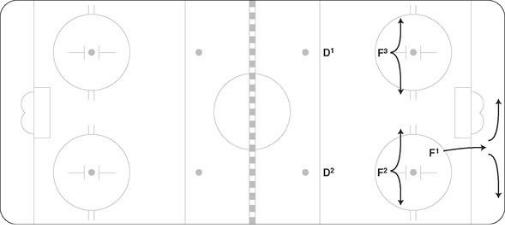
As mentioned in the breakout section, there are four ways the opponent can break out, so it is important when discussing forechecking systems to outline how to shut down each breakout. Listed here are the various breakout options and the specifics of how to react when forechecking in a 1-2-2 formation.
Up
F1 pressures O1. F2 and F3 position themselves in line with the dots, even with the opposing wingers and ready to take away passes up the boards. Initially, the wingers can also line up wider to prevent any quick rim plays, but we prefer that they stay inside to minimize mid-ice space and then move to an outside position. If O1 passes to O4, then F2 closes quickly and F3 moves across, locking the middle (preventing passes to the center) (figure 6.2).
Figure 6.2 The 1-2-2 forecheck versus up.
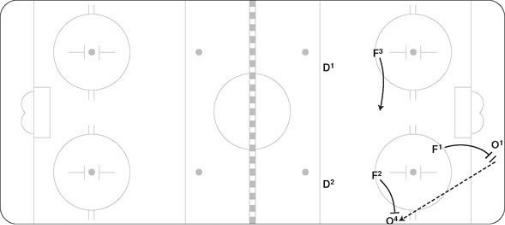
Over
F1 pressures O1, and on the pass, F3 moves down to take away the pass to O2. F2 moves across to take away the pass up to O5. F1 recovers quickly and locks the middle (figure 6.3). If the puck is moved in the same direction while F1 is chasing O1, then F1 should continue to pressure 02 while F2 and F3 hold their positions.
Figure 6.3 The 1-2-2 forecheck versus over.
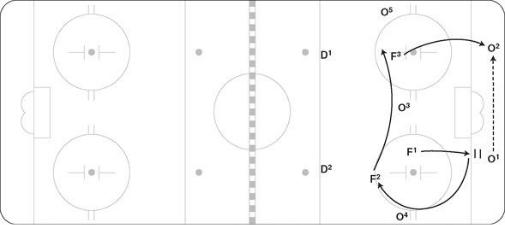
Wheel
F1 forces O1 as he wheels the net while F2 locks across the middle. F3 backs up while staying inside the dots and is ready to take away the boards. F1 should force only if he is within one stick length of O1. If not, he should cut across the front of the net and pick up O1 on the other side (figure 6.4).
Figure 6.4 The 1-2-2 forecheck versus the wheel.

Reverse
F1 forces O1 as he wheels the net, and then as O1 reverses the puck, F2 closes on the pass. F3 moves across to lock the middle. It is important that F1 recover high on the back side (figure 6.5).
Figure 6.5 The 1-2-2 forecheck versus a reverse.
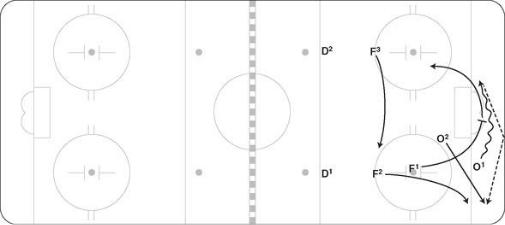
Rim
F1 pressures O1. If the puck is rimmed to the wide side, then D2 moves down to pinch on the winger. F3 covers up for D2 by moving up to the corner of the blue line. If the puck is rimmed up the strong side, then F2 closes down on the winger (figure 6.6).
Figure 6.6 The 1-2-2 forecheck versus a rim.
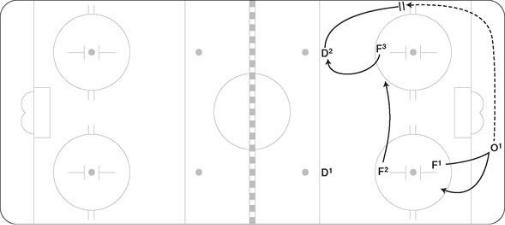
2-1-2 Forecheck
This type of forechecking system was made famous by the Edmonton Oilers of the 1980s, who used their high-powered attack to pressure teams hard and recover the puck. This system forces the opponent’s defense to handle pressure while also taking away all options up the boards. This is also a physical forecheck because F1 and F2 are in deep and looking to finish hits while the defense are set to come down the boards when the puck is moved to the opposition wingers. The 2-1-2 forecheck forces teams to use the middle of the ice to escape the zone. The strength of the system is in the pressure it applies while at the same time giving the opponent only certain areas to break out of the zone. The weakness of the 2-1-2 system is that at times you have a defenseman pinching and a forward back on defense accepting the rush when the opponent breaks out. Most forwards are weaker at defending the rush than any of the six defensemen. Figure 6.7 shows the details of the system.
Figure 6.7 The basic 2-1-2 forecheck.
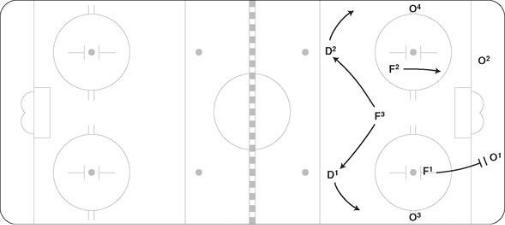
F1 pressures O1 to put the puck up the boards or across to his partner. F1 generally will have an opportunity to finish his hit on O1. Once the puck is moved and F1 has finished the hit, he recovers on the same side of the ice. F2 moves down on the weak side, anticipating a pass to O2. If the puck is moved up to O4, then F2 starts to recover on the same side.
F3 maintains a high position between the two defensemen. When D1 or D2 pinches down on a pass, then F3 moves out to the blue line on that side and backs up the D. If the opposition starts to break out, then F3 will have to back up like a defenseman. F3 is available in a solid defensive position, but once the puck is turned over, he is ready to receive a pass in the prime scoring area. At times F3 will move in offensively. As a result, when the puck is turned over, F2 or F1 may rotate into this position.
Both defensemen must read the play and anticipate when the puck may move up the boards. Once they see a pass is being made, they should pinch down (move toward the winger quickly, not letting him get by) on the winger. Finish hits on the winger but remain in control. When the puck moves away, get back to the blue line. Sometimes coaches talk about a pre-pinch position where the defensemen are one-third of the way down the boards when the
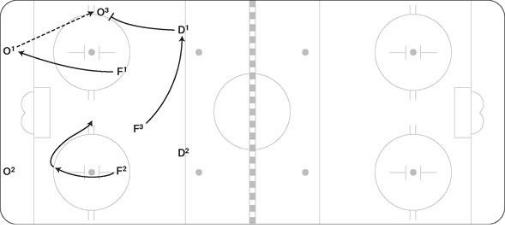
puck is on that side. This makes the distance to pinch on the winger much shorter.
Listed below are the various breakout options and the specifics of how to react when forechecking in a 2-1-2 formation
Up
F1 pressures O1 to move the puck up the boards (figure 6.8). F2 moves down half way on the wide side ready to close on O2. F3 stays in the middle of the ice. D1 moves down quickly on the pass to 03. F3 fills in for D1.
Figure 6.8 The 2-1-2 forecheck versus up.
Over
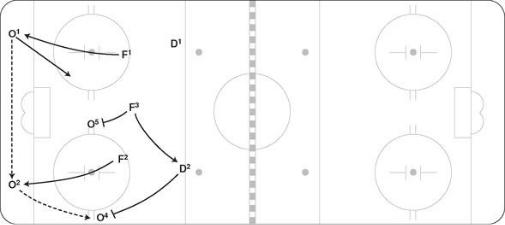
F1 pressures O1, and on the pass, F2 closes quickly on O2 (figure 6.9). If O2 passes the puck up the boards to the winger then D2 moves in and finishes the hit on 04 while F3 fills in on the blue line. If O2 tries to pass to the middle of the ice then F3 takes away O5.
Figure 6.9 The 2-1-2 forecheck versus over.
Wheel
F1 forces O1 as he wheels the net while F2 moves down to prevent O1 from rounding the net and makes him pass to the boards (figure 6.10). D2 closes down on the board pass while F3 fills in on the blue line.
Figure 6.10 The 2-1-2 forecheck versus the wheel.
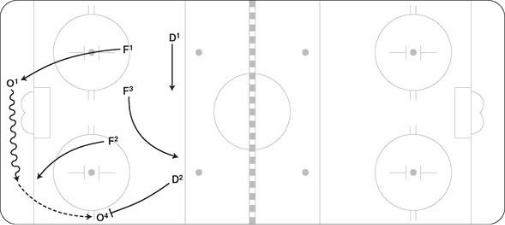
Reverse
F1 forces O1 as he wheels the net (figure 6.11). F2 is ready to stop O1 from wheeling and then once he sees the reverse to O2 moves in quickly to that side. F3 takes away the middle ice pass and is also ready to fill in for D1 if he pinches on a pass to the boards.
Figure 6.11 The 2-1-2 forecheck versus a reverse.
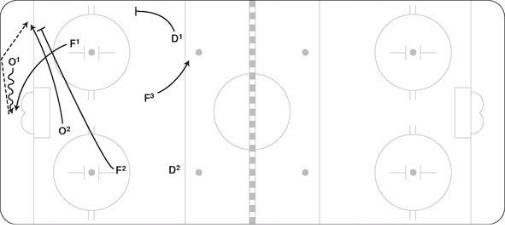
Rim
F1 pressures O1. If the puck is rimmed to the wide side, then D2 moves down to pinch on the winger (figure 6.12). F3 covers up for D2 by moving up to the corner of the blue line. If the puck is rimmed up the strong side, then D1 pinches with F3 once again filling in.
Figure 6.12 The 2-1-2 forecheck versus a rim.
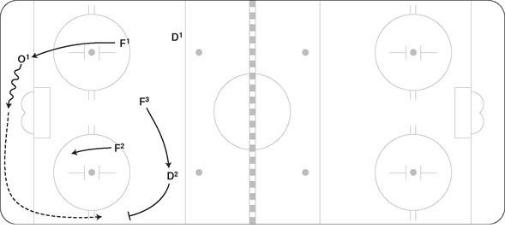
2-3 System or Left-Lane Lock
In the 2-3 system, the key component is the pressure exerted by F1 and F2. They pressure the defensemen and each pass by skating constantly, finishing hits, and recovering quickly. The harder they work, the more hits they finish, and the quicker they recover, the more effective the system is. The 2-3 system is often referred to as the left-lane lock because one forward (F3) stays back on the left side of the ice—eliminating breakouts up those boards. The reason the left side was originally picked is because left wingers are traditionally better defensively than right wingers, while right wingers are traditionally the scorers. The defensemen shift to the right side, with the left D playing in mid-ice and the right D playing the right boards (figure 6.13).
Once the puck is turned over, the left winger can move in offensively, but then he has to move back when the puck is in doubt or turned over. The “lock” player doesn’t always have to be the left winger; teams may decide to always use their top defensive player there or use a reading system where the left side is filled at any time by the closest player. Often it is better to designate one player to have this responsibility. If you don’t designate exactly who should be in this position, most times you will have confusion with the read and end up with no one there, two players there, or players moving to the area late. Listed below are the various breakout options and the specifics of how to react when forechecking in a 2-3 or Left Lane Lock System.
Figure 6.13 The 2-3 system or left-lane lock.
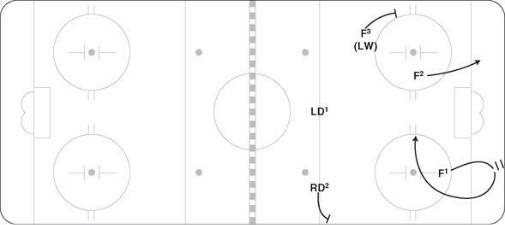
Up
F1 pressures O1 to move the puck up the boards (figure 6.14). F2 moves down ½ way on the wide side way ready to close on O2. F3 is on the far boards. D2 is in mid ice. D1 moves down quickly on the pass to O3. D2 covers up for D1 and F3 fills in wide on the blueline.
Figure 6.14 The 2-3 versus up.
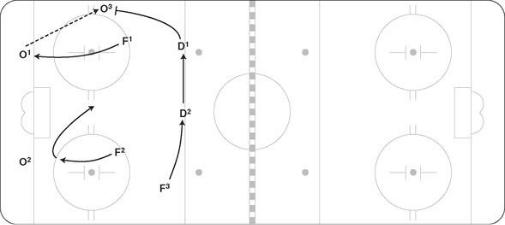
Over
F1 pressures O1, and on the pass, F2 closes quickly on O2 (figure 6.15). If O2 passes the puck up the boards to the winger then F3 moves in and finishes the hit on O4 while D2 fills in on the blue line. D1 moves to mid ice.
Figure 6.15 The 2-3 versus over.
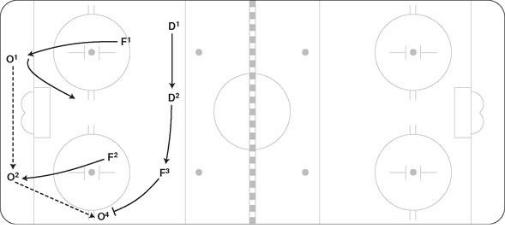
Wheel
F1 forces O1 as he wheels the net while F2 moves down to prevent O1 from rounding the net and makes him pass to the boards (figure 6.16). F3 closes down on the board pass while D2 fills in on the blue line and D1 moves to mid ice.
Figure 6.16 The 2-3 versus the wheel.
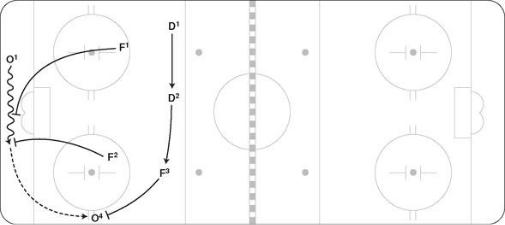
Reverse
F1 forces O1 as he wheels the net (figure 6.17). F2 is ready to stop O1 from wheeling and then once he sees the reverse to O2 moves in quickly to that side. D1 takes away any pass to the strong-side boards. D2 fills in if D1 pinches on a pass and F3 stays in mid ice on the blue line.
Figure 6.17 The 2-3 versus a reverse.
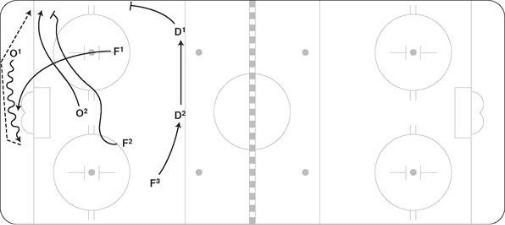
Rim
F1 pressures O1. If the puck is rimmed to the wide side, then F3 moves down to pinch on the winger (figure 6.18). D2 covers up for F3 by moving up to the corner of the blue line. If the puck is rimmed up the strong side, then D1 pinches with D2 once again filling in.
Figure 6.18 The 2-3 versus a rim.
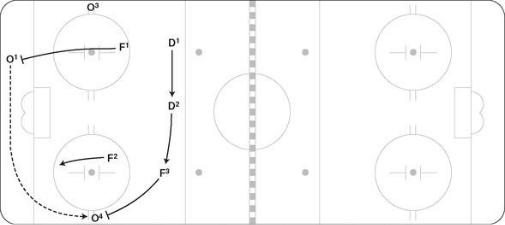
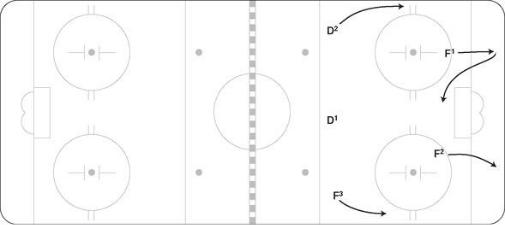
Torpedo System
This interesting system was developed in Sweden and is not as commonly used in North America. It is very similar to the leftwing lock system but different in strategy.
The system is called torpedo because the first two forwards in on the forecheck buzz from corner to corner, pressuring the puck. The third forward (F3), who is usually the center, stays high on one side. The defensive defenseman stays in the center of the blue line and is more of a safety. On the opposite side of F3 is the offensive defenseman. The offensive defenseman and the center have the freedom to pinch down hard on all passes up their boards and also move in offensively when F1 and F2 have puck possession. Some coaches will allow F3 and D2 to pinch all the way down the boards to the goal line on that side (figure 6.19).
Figure 6.19 The torpedo system.
The advantage of this system is that F1 and F2 always provide
pressure on the opposing defense, while passes up the boards are shut down by F3 and D2. Also when the puck is turned over, there are two potential passing options for F1 and F2. Offensively, F3 and D2 are always ready to jump in to receive a pass or take a shot. For this system to work effectively, the center (F3) must be good at playing back defensively because if D2 gets caught in the zone, F3 will have to play defense with D1. Few teams are as comfortable with their centers playing back as they are with their defense. Also the wingers who get in on the forecheck must be good, quick skaters who can “buzz” from side to side. As with other systems, the weakness in the torpedo system is that the middle of the ice is available for breakout plays. Although the torpedo is nontraditional and sometimes disregarded because of that, if you have the personnel to fit the descriptions of the positions, it is definitely worth trying.
Diagrams and descriptions for the breakout options have not been included here because the rotations are the same as 2-3 System. The one variation is that the center is back on the far side and the outside players F3 and D1 pinch very aggressively on any passes up the boards. They even try to anticipate the pass being made and pinch early, not giving the wingers any opportunity to get the puck.
Control Forecheck
A control forecheck is used when the opposing players are set up behind their net with full control of the puck. This may happen off a line change or when the opponent gains the net and stops before you can apply pressure. Usually it doesn’t make sense to force them out from behind the net because you will lose one forechecker and they will have an easy escape. The only exception to this would be if the first forchecker can get in to flush the defenseman quickly and surprise him before the other team has time to get organized. Once the opponent stops behind the net, there are a couple of ways to forecheck off the control setup.
Deep Trap
Much like the neutral zone forecheck, all five players back up and meet the attack at the blue line. F1 takes a shallow angle and steers the puck carrier to one side. The forward on that side (F2) stands up and denies the team from gaining the red line. F3 can lock across or stay wide. This is a more conservative strategy that forces opponents to move through the neutral zone against a lot of traffic with five defenders in this area. The opposition will have time and space to build up speed, but once they hit the blue line it will be taken away, and turnovers often result (figure 6.20).
Figure 6.20 The deep trap.
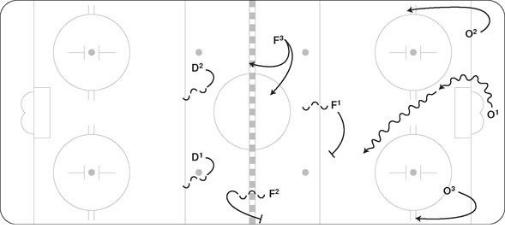
Swing With Speed
Most offensive teams on a control breakout will swing one player behind the net with speed and stretch at least one other player. One way to neutralize this speed is to swing either the center or one of the wingers with their forward going behind the net. In this case, F1 backs out and lets F2 swing in with a good angle to take away the forward going behind the net. If the player going behind the net is moving the other way, then F3 would move in. If the opposing D holds onto the puck and moves out from behind the net, now F3 would move in on an angle to force the puck carrier to one side. The defense must be aware of any stretch players because it is important to eliminate the threat of the long stretch pass. This control forecheck is effective in eliminating opposition speed but does open up some areas of the ice for them to make plays. The defenders are stretched out more than in the deep trap (figure 6.21).
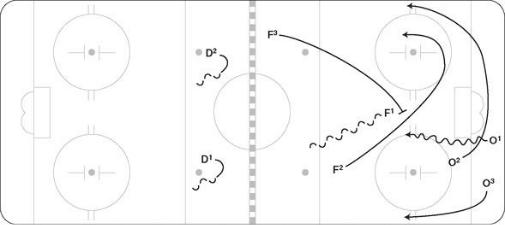
Figure 6.21 Swing with speed.
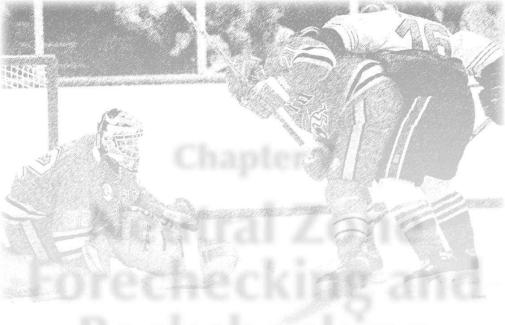
Chapter 7
Neutral Zone Forechecking and Backchecking
The neutral zone has changed dimensions over the last several years, which has dramatically altered the way teams defend this area. At almost all levels and in most leagues, the two-line pass is now allowed which opens up new options in this zone. Breakout teams are able to move the puck to the far blue line from behind their own net and while skating up ice can move the puck at any time to the far blue line (figure 7.1). Teams and coaching staffs are constantly talking about how much pressure they want to apply
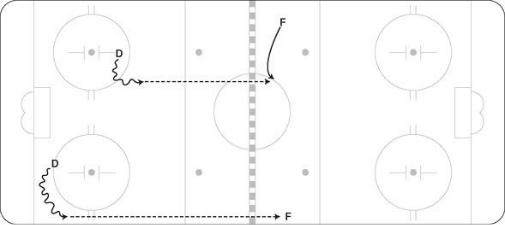
versus how passive they want to be. There is a lot of space to cover, so it is a double-edged sword. If you pressure, opponents have less time and may make mistakes, or they may take advantage of the extra space to work with. Conversely if you sit back, opponents have more time to read and make a play, but they have less space to work with. What do you do? Coaches have several options when designing the neutral zone forecheck.
Figure 7.1 Breakout teams can now move the puck at any time to the far blue line.
